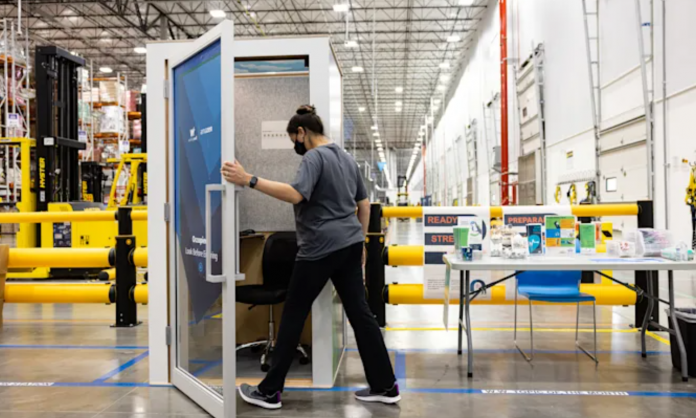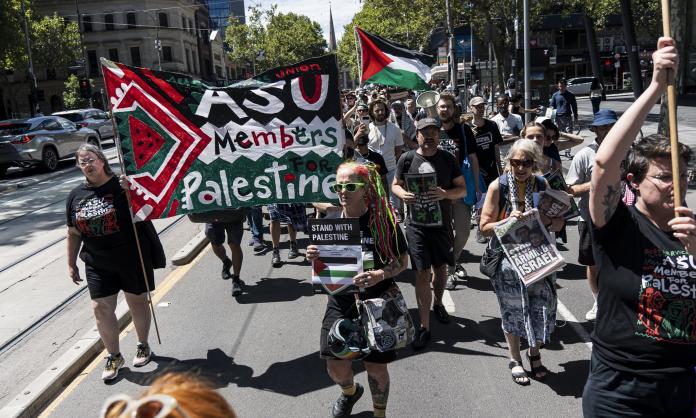Amazon’s latest employee wellness initiative—the installation of “AmaZen mindful practice rooms” in its warehouses—could easily have been something from the Netflix sci-fi series Black Mirror. It has exactly the balance of the familiar (anyone who has been subject to faddish “employee wellness” programs will recognise the grift) and the sinister (in the “mindful practice room”, can anyone hear you scream?).
Perhaps, however, the concept is too lame. The plot lines of Black Mirror generally involve the use of new technologies for dystopian ends. An AmaZen booth is the kind of thing you might get if you asked a group of year nine science students to build a Black Mirror-like dystopian technology out of materials gathered from hard rubbish.
The rooms, which aren’t much bigger than a coffin, are equipped with a swivel chair and pictures of clouds pasted to the ceiling. Inside, employees can watch short positive affirmation and guided meditation videos.
The introduction of the AmaZen booths is part of Amazon’s broader WorkingWell program. Other program absurdities include “Wellness Zones”, areas in warehouses set aside for workers to do stretches, and “Mindful Moments”, hourly prompts from the workstation surveillance technology directing employees through breathing exercises and mental reflections.
Unsurprisingly, there has been a backlash. Amazon quickly pulled its promotional video from Twitter after replies pointing out that the booths looked like “cry closets” or “tiny capitalism panic rooms”. More generally, Amazon’s attempted rebranding as a wellness employer isn’t convincing anyone. After all, the company puts so much pressure on employees that some reportedly resort to pissing in bottles in an effort to meet stringent productivity quotas.
Amazon is not the only business to introduce bullshit “employee wellness” schemes. Corporate wellness initiatives have boomed in the last decade, particularly in white-collar workplaces. A 2018 US National Business Group on Health survey of 163 companies found that 52 percent offered some form of mindfulness training to employees, up from 36 percent the year before.
Not all such initiatives are as sinister as Amazon’s “cry closets”. They range from bog-standard one day “mindfulness and resilience” professional development programs to much more elaborate affairs.
Intel’s Awake@Intel program, for example, offers employees the chance to participate in a ten-week mindfulness and meditation course that promises a “better self at work and beyond”. A post on the “WeAreIntel” blog, written by Intel’s content marketing manager, effused that the mindfulness it teaches “not only helps to manage stress, but also to develop laser-like focus for efficiency and productivity inside and outside of the company”.
Google’s Search Inside Yourself program—created in 2007 by company engineer Chade-Meng Tan—has since been spun off into an independent Search Inside Yourself Leadership Institute (SIYLI). SIYLI offers “transformational experiences backed by world experts in neuroscience, mindfulness and emotional intelligence” and boasts clients in more than 50 countries.
What all such programs have in common, beneath the warm and fuzzy rhetoric, is the promise of improved health and wellbeing, not for employees, but for business bottom lines. For example, take SIYLI’s account of the positive impact of mindfulness training at German multinational software company SAP:
“For starters, the training has boosted employee engagement and reduced absenteeism. According to SAP’s calculations, a 1 percentage point increase in employee engagement corresponds to anywhere from 50 to 60 million euros in operating profit. At the same time, a 1 percentage point increase in its business health culture index can boost profits by 85 to 95 million euros. Another quantifiable result: SAP’s strong first-quarter results for 2018 and its steadily rising performance in the New York Stock Exchange, especially in recent years.”
There may of course be marginal benefits for workers taking part in these programs. Having a break from the daily grind, even if it’s just to undertake bullshit mindfulness exercises, can help reduce stress temporarily. But corporate mindfulness offers no solutions to the main sources of working-class stress: job insecurity, low wages and being worked like a machine. In fact, the mindfulness industry is designed to prevent these issues being addressed.
Instead of correctly placing the blame for bad working conditions on the bosses, corporate mindfulness teaches us that stress is a product of inadequate mental resilience. With mindfulness (so the theory goes), we can take these stressful thoughts, place them on an imaginary leaf, and send them floating down a calm, trickling stream. After unburdening ourselves from our own minds, we can get back to working harder than ever.
In the case of Amazon, the launch of the WorkingWell program couldn’t be more transparently associated with concerns about workplace organising. Over the last few years, there have been staff walkouts at Amazon facilities in the US, the UK and Europe during the annual Prime Day sales event. In March, up to 75 percent of Amazon’s logistics workers in Italy went on strike. There was also an attempt by Amazon workers in Bessemer, Alabama, to unionise.
Unlike corporate mindfulness training, workplace organising has tangible benefits that go well beyond a momentary reduction in stress. This was illustrated in the aftermath of the vote in Bessemer, when Amazon worker and union activist Jennifer Bates gave a speech that, despite her disappointment at the lost vote, exuded the kind of joy, confidence and determination that could never be achieved through guided meditation.
“Victory will come. Not just here in Birmingham or Bessemer, but around this nation”, Bates said. “The fire has started. Burn, let it burn!” And she is right: the fire started in Bessemer is spreading, with union activists now targeting another major Amazon warehouse in New York. As these workers get organised, in addition to winning better wages and conditions, some might find inner peace by taking to one of the AmaZen booths with a sledgehammer. Namaste.










